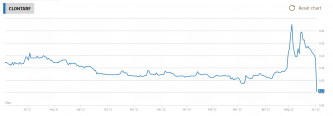Key points:
- Clontarf's down 70% and change on bad news
- Sasanof-1 has come up as a dry well
- Bit of a pity they spent all that money to buy into it a month ago
Clontarf Energy (LON: CLON) shares are down 72% this morning on the back of the results from Sasanof-1. It's a dry well, no hydrocarbons found. The big question now being, well, where does Clontarf go from here? Having a licence is all very well but if there's nothing to extract there then it's not worth a great deal, is it?
Clontarf can at least act as a useful lesson for us about resource shares. Here's the recent Clontarf share price:

It's not just that 70% and change fall right at the right that we need to look at. It's the leaps that come before too which tell us about how resource shares often work. There's that leap in April and early May. This driven by the placing of shares and the acquisition of 10% of that Sasanof project. The excitement being that the company has bought into a highly prospective, umm, prospect. The price seemed reasonable too – $4 million in cash plus shares in Clontarf to the value of about – at the time – £450k. Looked like a good deal at the time too.
Also Read: Best Oil Stocks to Buy Right Now
Then we've another peak as we get to the well mobilisation – people pretty clearly betting on the idea that now the drilling rig is there, it's only weeks before we find we've just bought into a new and grand field.
Then we get to today's results which are less exciting:
The Sasanof-1 exploration well has been drilled to a total depth of 2,390 metres (RMDT) by the Valaris MS-1 rig, without incident.
No commercial hydrocarbons were intersected.
This is less than happy news of course. For what we've now got is that a month back Clontarf raised £3.5 million to buy into a project which a month later turns out to be a dry well. Which will now be plugged and that's that.
This is a rather shorter time scale than is usual in resource exploration, it doesn't normally take just that one month. But the result itself isn't all that unusual. It's necessary to explore the world to find out where there are those little pockets of exploitable minerals. This is as true of oil and gas as it is of gold, copper or any other mineral. Money must be spent to do that exploring.
That requires raising capital in order to go drilling. Sure, solid minerals and hydrocarbons use different drilling rigs but the base idea is the same – make a hole and see what's down there. Sometimes and often enough nothing interesting is.
At any stage it's possible to offload some of the risk – in return for some portion of any future profit – and equally, as must be true, it's possible to buy in at any particular risk stage. Which is just what Clontarf did. The price to buy in before the Sasanof-1 well was drilled was lower than it would have been afterwards if oil or gas had been found. But higher than if it wasn't. That's the risk taken.
The lesson to take away from this is that any natural resource share is inherently risky. Simply because there just might not be any natural resources where they're looking.
As to what Clontarf does next well, we'll no doubt find out but this specific project seems to be pretty much over.
